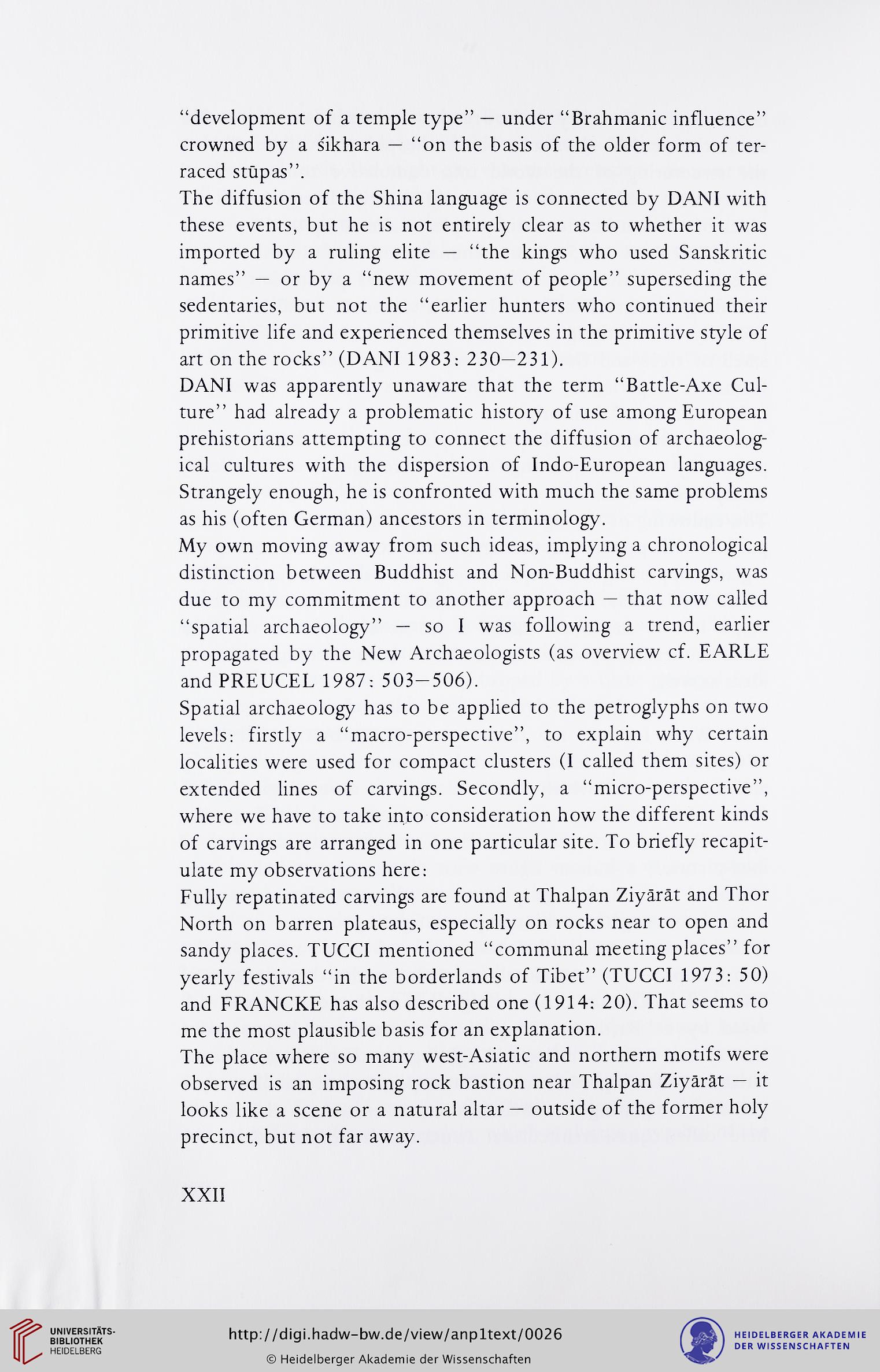"development of a temple type" — under "Brahmanic influence"
crowned by a sikhara — "on the basis of the older form of ter-
raced stupas".
The diffusion of the Shina language is connected by DAN! with
these events, but he is not entirely clear as to whether it was
imported by a ruling elite — "the kings who used Sanskritic
names" — or by a "new movement of people" superseding the
sedentaries, but not the "earlier hunters who continued their
primitive life and experienced themselves in the primitive style of
art on the rocks" (DAN1 1983: 230—231).
DANI was apparently unaware that the term "Battle-Axe Cul-
ture" had already a problematic history of use among European
prehistorians attempting to connect the diffusion of archaeolog-
ical cultures with the dispersion of Indo-European languages.
Strangely enough, he is confronted with much the same problems
as his (often German) ancestors in terminology.
My own moving away from such ideas, implying a chronological
distinction between Buddhist and Non-Buddhist carvings, was
due to my commitment to another approach — that now called
"spatial archaeology" — so I was following a trend, earlier
propagated by the New Archaeologists (as overview cf. EARLE
and PREUCEL 1987: 503-506).
Spatial archaeology has to be applied to the petroglyphs on two
levels: firstly a "macro-perspective", to explain why certain
localities were used for compact clusters (I called them sites) or
extended lines of carvings. Secondly, a "micro-perspective",
where we have to take into consideration how the different kinds
of carvings are arranged in one particular site. To briefly recapit-
ulate my observations here:
Fully repatinated carvings are found at Thalpan Ziyarat and Thor
North on barren plateaus, especially on rocks near to open and
sandy places. TUCC1 mentioned "communal meeting places" for
yearly festivals "in the borderlands of Tibet" (TUCCI 1973: 50)
and FRANCKE has also described one (1914: 20). That seems to
me the most plausible basis for an explanation.
The place where so many west-Asiatic and northern motifs were
observed is an imposing rock bastion near Thalpan Ziyarat — it
looks like a scene or a natural altar — outside of the former holy
precinct, but not far away.
XXII
crowned by a sikhara — "on the basis of the older form of ter-
raced stupas".
The diffusion of the Shina language is connected by DAN! with
these events, but he is not entirely clear as to whether it was
imported by a ruling elite — "the kings who used Sanskritic
names" — or by a "new movement of people" superseding the
sedentaries, but not the "earlier hunters who continued their
primitive life and experienced themselves in the primitive style of
art on the rocks" (DAN1 1983: 230—231).
DANI was apparently unaware that the term "Battle-Axe Cul-
ture" had already a problematic history of use among European
prehistorians attempting to connect the diffusion of archaeolog-
ical cultures with the dispersion of Indo-European languages.
Strangely enough, he is confronted with much the same problems
as his (often German) ancestors in terminology.
My own moving away from such ideas, implying a chronological
distinction between Buddhist and Non-Buddhist carvings, was
due to my commitment to another approach — that now called
"spatial archaeology" — so I was following a trend, earlier
propagated by the New Archaeologists (as overview cf. EARLE
and PREUCEL 1987: 503-506).
Spatial archaeology has to be applied to the petroglyphs on two
levels: firstly a "macro-perspective", to explain why certain
localities were used for compact clusters (I called them sites) or
extended lines of carvings. Secondly, a "micro-perspective",
where we have to take into consideration how the different kinds
of carvings are arranged in one particular site. To briefly recapit-
ulate my observations here:
Fully repatinated carvings are found at Thalpan Ziyarat and Thor
North on barren plateaus, especially on rocks near to open and
sandy places. TUCC1 mentioned "communal meeting places" for
yearly festivals "in the borderlands of Tibet" (TUCCI 1973: 50)
and FRANCKE has also described one (1914: 20). That seems to
me the most plausible basis for an explanation.
The place where so many west-Asiatic and northern motifs were
observed is an imposing rock bastion near Thalpan Ziyarat — it
looks like a scene or a natural altar — outside of the former holy
precinct, but not far away.
XXII




